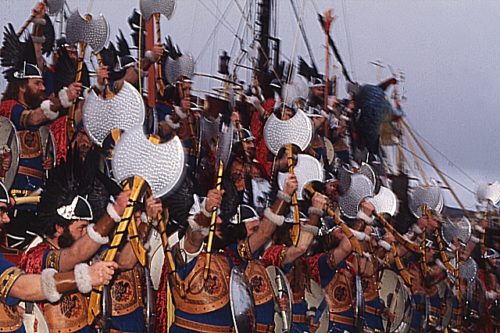UNITED KINGDOM — Winter in the UK is often a dull and dreary affair. The winds are cold and biting, the skies are grey and loaded with drizzle. Any snow, with its temporary sense of wonder and magic, tends to be short-lived. So what do we have to get us through the Winter Fire festivals!
![Up Helly Aa [Photo Credit: A. Burgess / Wikimedia]](https://wildhunt.org/wp-content/uploads/2017/02/UpHellyAa7AnneBurgess30Jan1973-500x389.jpg)
Up Helly Aa © Copyright Anne Burgess
Peterson adds: “For many Shetlanders, it’s bigger than Christmas and New Year put together.”
Over recent years, the Up Helly Aa festival has seen an explosion of popularity. The event, whose name roughly translates as “End of Holy/holiday time for all,” marks the end of Yuletide on the Shetland Isles. Its date can alter as it is celebrated on the last Tuesday in January.
The Up Helly Aa tradition is an old one and originally involved the practice of tar barrelling, where barrels of tar were set alight and rolled around the streets in a procession with accompanying mischief making. This is likely to be a nod to the Lord of Misrule antics that often traditionally accompany festivals around such as this time. Since Christianity’s arrival, these traditions have been more associated with Epiphany.
Tar barrelling was phased out during the mid 19th century, and the more modern ceremony slowly evolved over that period. By the turn of the century, the galley ship and torchlit precession were firm fixtures of the Up Helly Aa festival. Today, the procession consists of roughly 1,000 torchbearers, known as guizers, making their way to a central spot where a huge Viking galley awaits.
The guizers form different squads, and the whole event is led by the Guizer Jarl, who has his own squad of between 50 and 70 men. This group has formed the Jarl Squad for Up Helly Aa since the 1920s. The squad dresses in Viking regalia and calls themselves Vikings for a day.
A new galley is custom built every year for the festival. As the procession gathers, the guizers move around the boat in a spiral with each member throwing their torch into the boat. As the boat catches fire, wishes for the new year are taken to the gods. The current Up Helly Aa celebrations are held at 10 different locations on Shetland.
The festival is also a celebration of Shetland’s Viking roots.The Norn language, directly related to Old Norse, only died out in the mid 19th Century, and the current dialect (Shetland Scots) spoken there has many Norse-related words in its vernacular. Due to its location – it is roughly the centre of a triangle between the Northern coast of Scotland, Norway and the Faroe Isles – Shetland has a prominent Viking history and many of its traditions and dialect share a Scandinavian lineage.
Even the costumes for the festival are given the utmost care and attention and are an important part of the ceremony. The Guizer Jarl wears a full suit of Viking armour which dates to the 1930s. Every year a new shield and suit design is commissioned for his men and preparations often begin up to two years in advance. Other squads are tasked with making their own suits.

Jarl Squad 1973 © Copyright Anne Burgess
The procession begins in the morning, when squads march into town and read The Bill which sets out the instructions for the day. This is usually light-hearted and informal direction. As the sun sets, which is early on Shetland, the squads make their way to the galley. As they approach the boat, they sing the Up Helly Aa song, followed by the Galley Song. Later they sing the Norseman’s Home as they come away from the boat. By that point, the galley is ablaze and is returning to Valhalla as described by Northern Tradition.
The guizers then retire to the local pubs, where lots of after-parties and dances take place, often into the next morning. The next day, thankfully, is a public holiday.
The popularity of these festivals continues to grow, drawing bigger and bigger crowds. Up Helly Aa is now streamed on You Tube. And other fire festivals are beginning to take root as Britain rediscovers its often neglected Viking links.
In the remote headland of Flamborough, East Yorkshire, a New Year’s Eve fire festival began two years ago as a celebration of the area’s Viking history. Like Up Helly Aa, the Flamborough Fire Festival also has a torchlit procession, during which a Viking longship is drawn through the streets.
This is a reenactment of an 8th Century Viking invasion at Flamborough and the settlements that existed there for hundreds of years since. The crowds are encouraged to throw coins into the longship for good luck. Throwing money into wells and fountains is a well-known European custom, and it manifests here in this newer event.
The Flamborough festival also has fire swallowers as part of its procession, which is said to be based on an old Northern tradition of using fire to clear the air to make way for the new energy of the year.
Speaking to the Scarborough Evening News, organisers Jane Emmerson and Pam Sayer said: “The Festival is a very special event to celebrate Flamborough’s Viking heritage, as we believe Flamborough is the home of the Vikings.”
The Vikings may be gone but more and more Britons are keeping their fire burning.
The Wild Hunt is not responsible for links to external content.
To join a conversation on this post:
Visit our The Wild Hunt subreddit! Point your favorite browser to https://www.reddit.com/r/The_Wild_Hunt_News/, then click “JOIN”. Make sure to click the bell, too, to be notified of new articles posted to our subreddit.

I love seeing stuff like this. There is an Pagan reawakening afoot in the West!